The Caspian Sea has a major claim to fame: it’s the world’s largest inland body of water, also referred to as the largest lake in the world (although this is up for debate). The sea is also nestled between Europe and Asia, borders five different nations, and is home to a variety of valuable resources.
The five countries on the Caspian Sea are Russia, Kazakhstan, Turkmenistan, Iran, and Azerbaijan. Each of these has its own unique history, culture, and geography, but they’ve all been influenced by their proximity to the same sea.
In this post, we’ll learn more about the relationship between the Caspian Sea and its bordering nations, diving into the way elements like culture, history, and economics have been shaped in each. Below, you’ll find a Caspian Sea Region Map that shows the borders of the five countries that border the Caspian Sea as well as some major cities.
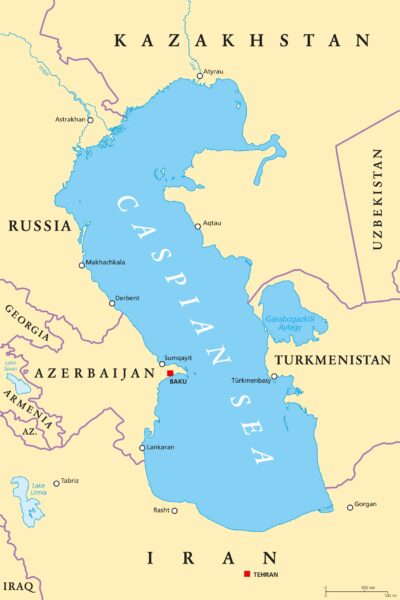
Russia
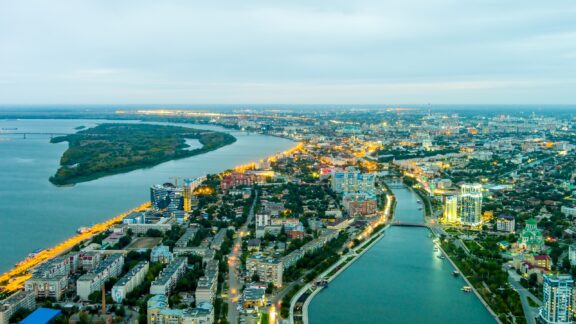
Spanning two continents, Russia is the largest country in the world, and a significant portion of its southern border is formed by the Caspian Sea. This vast expanse of coastline is characterized by a diverse range of landscapes and a rich diversity of cultural influences. Russia is also the only country on the Caspian Sea to also border the Black Sea.
One of the key coastal cities along the Russian Caspian shore is Astrakhan. Situated at the confluence of the Volga River and the Caspian Sea, Astrakhan has been a vital trading and cultural hub for centuries. Its strategic location has made it a gateway for goods flowing into and out of Russia’s heartland, connecting the nation to Asia and global trade routes.
The Caspian Sea holds immense economic significance for Russia. Beyond trade, the sea’s waters harbor valuable resources, notably its sturgeon population. Sturgeon, known for their prized roe, produce the world-famous Caspian caviar, a delicacy whose supply has been threatened in recent decades.
The Caspian Sea also shapes the region’s natural beauty. The Volga Delta, where the mighty river meets the sea, is a haven for birdwatchers and wildlife enthusiasts. It is the largest river delta in Europe, and its unique environment is teeming with biodiversity.
Russia’s Caspian coastline is not only a source of economic prosperity but also a testament to the interplay between nature, culture, and commerce. It stands as a reminder of the enduring importance of this remarkable body of water in the world’s largest nation.
Kazakhstan
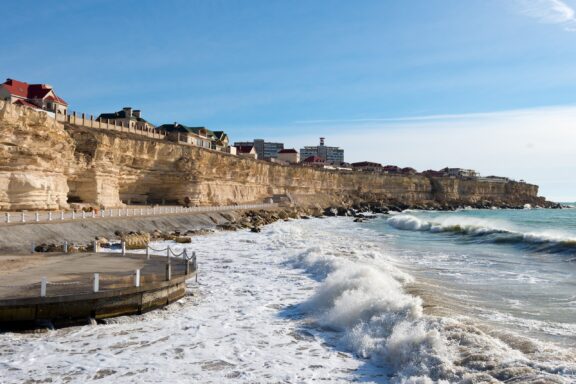
Kazakhstan is located in Central Asia and is the world’s largest landlocked country. It also boasts a substantial and diverse Caspian Sea coastline along its western border. This expansive stretch of Caspian coast is the longest of any country and offers a unique blend of natural beauty and cultural significance.
The coastal city of Aktau is Kazakhstan’s primary gateway to the Caspian Sea. Located strategically at the crossroads of maritime trade routes, Aktau has grown in importance over the years as a bustling port city. Its role as a maritime trade hub connects Kazakhstan’s vast interior to international markets, which enables economic growth and diversity.
Beyond its economic significance, the Caspian Sea holds cultural importance for Kazakhstan. The region’s history is intertwined with the sea, dating back to ancient civilizations that thrived along its shores. Archaeological sites and historical remnants dot the coastline and have added to the local tourism scene.
The Caspian Sea’s natural beauty is also a defining feature of Kazakhstan’s coastline. The shoreline ranges from serene beaches to lush wetlands, offering a diverse range of landscapes. The delta of the Ural River, which flows into the Caspian, is a unique ecosystem home to more than 250 bird species and attracts both nature enthusiasts and ecotourists.
Kazakhstan’s coast is not only a place of economic activity but also a testament to the nation’s cultural heritage. This is in part why efforts are being made to try and stop the shrinking of the Caspian Sea.
Turkmenistan
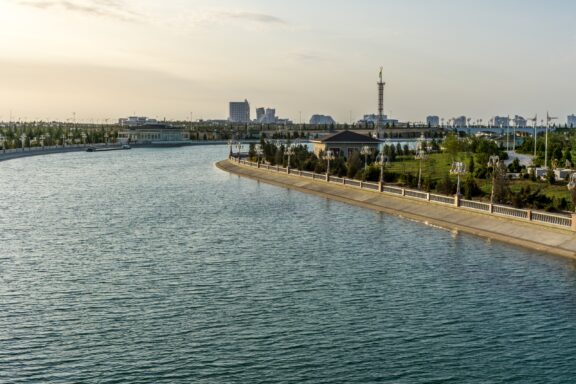
Another Central Asian country, Turkmenistan borders the southeastern corner of the Caspian Sea. Its coastline may be relatively short, but its strategic significance and economic importance are undeniably profound.
Turkmenistan’s access to the Caspian Sea serves as a critical lifeline, not only for the country itself but also for the broader region by providing Turkmenistan with the ability to engage in international trade and connect with neighboring nations. Its coastal area is centered around the city of Turkmenbashi and plays a pivotal role in the nation’s maritime and energy strategies.
The primary port city of Turkmenbashi has a long history as an important maritime gateway. The Turkmenbashi Port received a major upgrade and was opened in 2018, tripling its ability to handle cargo.
There is also great potential for Turkmenistan beneath the surface of the Caspian Sea. Vast reserves of oil and natural gas lie in its depths, making it a focal point for energy production and exploration.
Turkmenistan’s energy infrastructure includes pipelines that traverse the sea, connecting Central Asia’s resources to global markets and ensuring the nation’s role as a significant player in the energy sector. The country’s role in the global market is highlighted by its recent energy deal with the EU.
The Caspian Sea also offers opportunities for tourism and biodiversity preservation. The coastal region of Turkmenistan boasts incredible natural beauty and includes marine life that attracts interest from conservationists and researchers. Turkmenistan has been making strides to leverage these natural assets for its economic development.
Turkmenistan’s Caspian coast is a place of commercial, cultural, and natural significance. It’s vital to the nation’s strategic role in the region as well as its aspirations for a prosperous future.
Iran
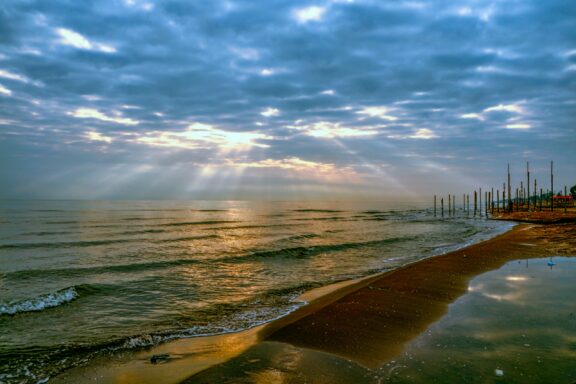
To the south of the Caspian Sea, Iran’s coastline stretches for hundreds of miles, offering a unique perspective on the sea’s cultural, historical, and economic significance.
The Iranian province of Gilan, along the Caspian coast, is renowned for its lush landscapes and vibrant culture. The provincial capital, Rasht, is a gateway to the sea, where it has played a central role in the lives of its people by shaping their traditions and cuisine. Rasht is part of the UNESCO Creative Cities Network.
The Caspian Sea holds great cultural importance for Iran. Throughout history, the region has been a hub of trade and cultural exchange, connecting Persia with the wider world. The sea’s influence is deeply embedded in Iranian traditions, art, and cuisine, with dishes featuring seafood known as Caspian Sea cuisine.
Iran’s share of the Caspian coast is not only rich in cultural heritage but also in natural beauty. The Caspian coastline in Iran features picturesque landscapes such as Chamkhale Beach and the lush Hyrcanian Forests.
In addition to its historical and cultural significance, the Caspian Sea plays a role in Iran’s economic activities. Fishing is a vital industry along the coast, providing sustenance and livelihoods for many coastal communities.
Iran’s Caspian coast is a place where history, culture, and nature converge. It serves as a reminder of the enduring importance of this remarkable body of water in shaping the nation’s identity and its future aspirations for a thriving coastal region.
Azerbaijan
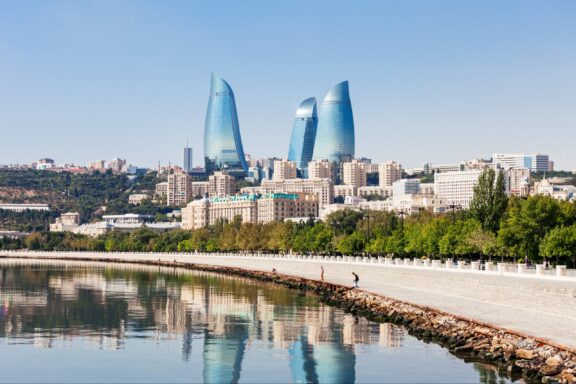
Azerbaijan, often referred to as the “Land of Fire,” graces the western coast of the Caspian Sea. The Caspian coastline here is a blend of modernity and antiquity, offering its own perspective on the sea’s cultural, historical, and economic significance.
At the heart of Azerbaijan’s Caspian coast lies its capital, Baku, a bustling metropolis that seamlessly blends modernity with historical charm. The city’s iconic Flame Towers illuminate the skyline, symbolizing Azerbaijan’s emergence as an economic powerhouse.
Baku’s role as an energy hub is deeply intertwined with the Caspian Sea, as it serves as a gateway to the vast hydrocarbon resources that lie beneath the sea’s depths. This connection has fueled Azerbaijan’s economic growth and diversification.
Beyond Baku’s modernity, the Caspian Sea coast holds cultural and historical gems. The Absheron Peninsula is dotted with ancient sites, including the Gobustan Rock Art Cultural Landscape, a UNESCO World Heritage site adorned with petroglyphs that tell the stories of Azerbaijan’s prehistoric inhabitants.
The Caspian Sea’s natural beauty is another defining feature of Azerbaijan’s coastline. The sea provides stunning views and recreational opportunities, including water sports and relaxation on picturesque beaches. Coastal cities like Sumgait and Lankaran offer unique perspectives on Azerbaijani life and culture, each with its own character.
Azerbaijan’s Caspian coast is not only about the past and present but also about the future. The nation’s strategic location and energy resources have prompted ambitious projects such as the Southern Gas Corridor, which aims to transport Azerbaijani gas to European markets.
Physical Features of the Caspian Sea
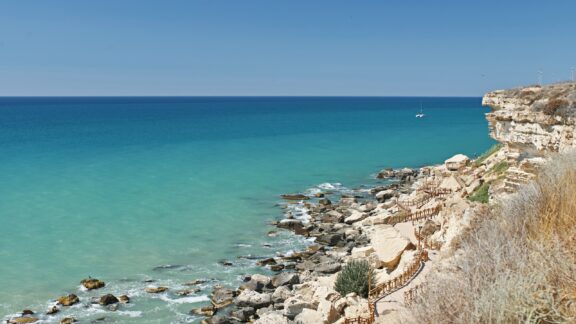
As well as its role in the various histories and cultures of the nations that border it, the Caspian Sea has its own interesting features when viewed as a whole. In this section, we’ll take a look at some of the physical properties of the Caspian Sea.
High Salinity
The Caspian Sea is a unique saltwater lake with varying salinity levels. Some areas are saltier than the world’s oceans, and this high salinity affects the sea’s ecosystem, contributing to the presence of distinct flora and fauna.
Closed Basin
As an endorheic or closed basin, the Caspian Sea has no outlet to the world’s oceans. This isolation leads to the accumulation of sediments and minerals, influencing the sea’s chemistry and geology.
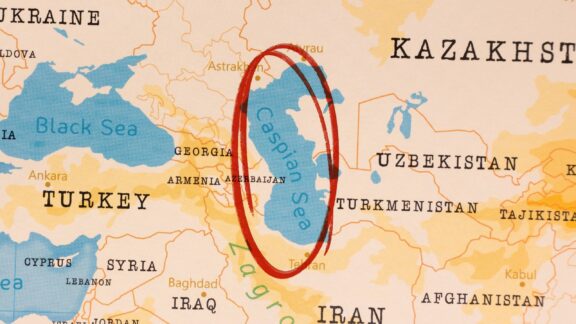
Biodiversity
The Caspian Sea hosts a diverse range of aquatic species, including various sturgeon species, fish, seals, and migratory birds. Scientific research in the Caspian focuses on understanding and preserving this unique biodiversity.
Environmental Challenges
The Caspian Sea faces environmental challenges, including pollution, overfishing, habitat degradation, and the impact of climate change. Scientific studies are essential for addressing these issues and implementing conservation measures.
More About Caspian Sea Countries: FAQs
What is the Caspian Sea’s maximum depth?
The Caspian Sea’s maximum depth reaches approximately 1,025 meters (3,363 feet) in the southern part of the sea.
Is the Caspian Sea getting smaller or larger over time?
The Caspian Sea’s water levels have fluctuated, with both shrinking and expanding phases over the years due to natural factors and human activities. In recent history, the sea has experienced shrinking.
Are there any islands in the Caspian Sea?
Yes, the Caspian Sea is home to numerous islands. The largest of these is the island of Ogurja Ada, located in the northeastern part of the sea.
What is the Caspian Sea’s climate like?
The Caspian Sea region experiences a diverse range of climates, from temperate along the northern coast to arid and desert-like conditions in the south.
Are there any endangered species in the Caspian Sea?
Yes, the Caspian Sea is home to several endangered species, including the Caspian seal and various sturgeon species, which are threatened due to overfishing and habitat degradation.
Does the Caspian Sea freeze during winter?
Yes, in the northern regions, particularly along the Russian and Kazakh coasts, the Caspian Sea can freeze during the winter months.
How important is the Caspian Sea for shipping and trade?
The Caspian Sea has been a vital transportation route for centuries, facilitating the movement of goods, which now include oil and gas, between Central Asia and the rest of the world.
Is the Caspian Sea connected to other bodies of water?
No, the Caspian Sea is not directly connected to any other sea or ocean.
What are the primary economic activities along the Caspian Sea’s coast?
Economic activities along the Caspian Sea’s coast include fishing, oil and gas production, shipping, tourism, and agriculture. Each nation bordering the sea has its own economic focus.
How do the Caspian Sea countries manage their shared resources?
The Caspian Sea’s legal status and resource management have been subject to negotiations among the five coastal nations.
The Convention on the Legal Status of the Caspian Sea, signed in 2018, outlines rules for the sea’s usage and exploitation of its resources.
Image Sources and Copyright Information
- Caspian Sea Region Political Map: Peter Hermes Furian/Shutterstock
- Twilight Panorama of Astrakhan, Russia with City Lights and River: © Maykova Galina/Shutterstock
- Stormy Waves Crashing Against the Quay in Aktau, Kazakhstan on the Caspian Sea: © Oleg Belyakov/Shutterstock
- Panoramic View of Awaza Tourist Zone with Canal and Resort Buildings in Turkmenistan: © JoostP/Shutterstock
- Serene Sunrise Over Bandar-e Anzali Port with Glistening Waters and Cloudy Skies: © Michal Knitl/Shutterstock
- Flame Towers Reflecting in Waterfront in Baku, Azerbaijan: © saiko3p/Shutterstock